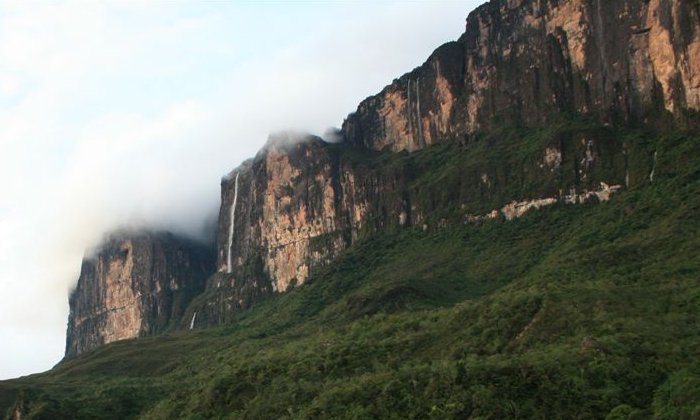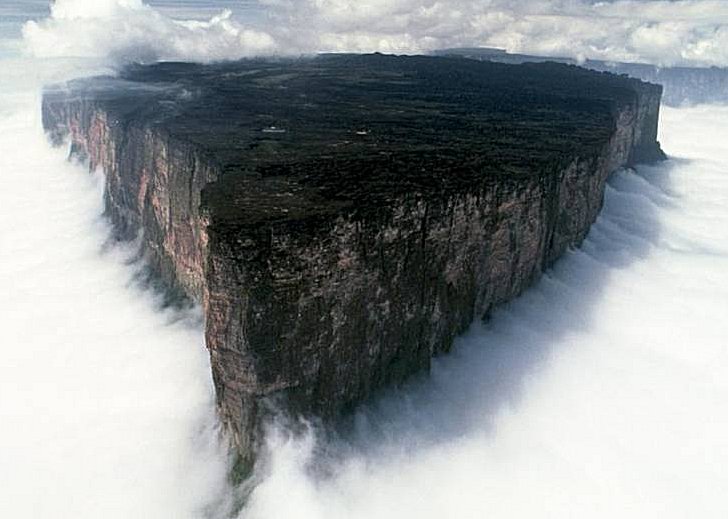Mysterious Mount Roraima Surrounded By Myths And Clouds Of Dense Fog
A. Sutherland - AncientPages.com - Mount Roraima is located on a high plateau at the junction of Brazil, Venezuela, and Guyana.
It was carved from a single, monolithic, gigantic piece of rock with sides forming a straight vertical line.
Mount Roraima cliffs, Venezuela. Paulo Fassina. Credit: CC BY-SA 2.0
Some researchers say Mount Roraima is not a mountain but an artificially created formation. Some others say it is a rather unique work of nature. Some just say - it's a scary thing.
The top of the vertical walls is up to 400 meters. The corner-sloping ledge forms a relatively sharp upper and lower line around the perimeter. The height of the ridge reaches 170 meters! The total size of the structure reaches 1,150 meters from its base.
The Pemon (Pemón or Pemong), who are indigenous people living in areas of Venezuela, Brazil, and Guyana, this fascinating formation must have played an essential role in their rich mythology. The Pemon's mythic tradition merged into their present Catholic and Christian faiths. In their beliefs, gods reside in the grassland area's table-top mountains called tepui.
Mount Roraima. Image source
The Pemon people believe the mountains are off-limits to the living, as they are also home to ancestor spirits called mawari.
The word tepui in the local Pemon people means' House of the gods,' For centuries, people avoided climbing Mount Roraima for fear of the gods' punishment. In addition, rumors went about strange creatures that lived on top of it.
In 1912, the first non-native person who visited Roraima to study Pemon myths and language seriously was the German ethnologist Theodor Koch-Grunberg.
Important myths describe the origins of the sun and moon, the creation of the tepui mountains that
spectacularly rise from the savannahs of the Gran Sabana and the activities of the creator hero Makunaima and his brothers.
In the language of Pemon Indians, 'roroi' means "blue-green," and 'ma' - "great." Thus, the name "Roraima" is translated from the local dialect and means "big blue-green mountain."
According to the beliefs of Aboriginal peoples, a stump was left from the mighty tree. This stump was a source of all the fruits and vegetables in the world. Legendary hero Makunayma - literally means "He Works By Night" - also known as "God" ("Great Spirit") cut down the tree, and the barrel fell to the ground and caused a terrible flood.
Makunaima is the great Creator god of the Akawaio (indigenous people in Roraima (Brazil), Guyana, Venezuela, and neighboring Caribean tribes.
Traditional Cariban cosmology has been mixed to some degree with Christian elements after the arrival of Christian missionaries.
Older myths from this region of the world feature Makunaima as a legendary cultural hero who slays monsters. In more recent sources, these heroic deeds are usually ascribed to the benevolent demigod Sigu (or Sigoo) instead of Makunaima.
In the Caribs' beliefs, the great god, Makunaima, is never personified, and mortal man has never seen him.
Roraima's cliffs can be climbed to the top, which takes approximately two days. However, in the course of lifting, the traveler risks falling into a cloud of dense fog, so you must be especially careful.
It is worth noting that Roraima Mountain's most unusual form is not particularly unique because there are similar rock formations around the world.
Written by – A. Sutherland - AncientPages.com Senior Staff Writer
Updated on January 10, 2022
Copyright © AncientPages.com All rights reserved. This material may not be published, broadcast, rewritten or redistributed in whole or part without the express written permission of AncientPages.com
Expand for referencesMore From Ancient Pages
-
 What Routes Did Homo Sapiens Take On His Way From Africa To Europe And Asia? Out Of Africa Path Examined
Archaeology | Dec 26, 2021
What Routes Did Homo Sapiens Take On His Way From Africa To Europe And Asia? Out Of Africa Path Examined
Archaeology | Dec 26, 2021 -
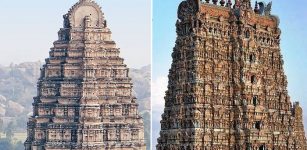 Vimana Temples – Architectural Marvel Of India
Civilizations | Dec 31, 2018
Vimana Temples – Architectural Marvel Of India
Civilizations | Dec 31, 2018 -
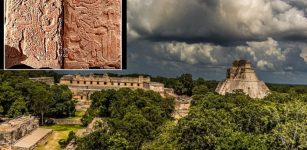 Ancient Maya Stela Carved On Both Sides Unearthed ‘In Situ’ In Uxmal, Yucatan Peninsula
Archaeology | Oct 31, 2022
Ancient Maya Stela Carved On Both Sides Unearthed ‘In Situ’ In Uxmal, Yucatan Peninsula
Archaeology | Oct 31, 2022 -
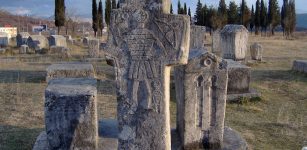 When And Why Did Humans Start Using Tombstones?
Archaeology | Aug 29, 2022
When And Why Did Humans Start Using Tombstones?
Archaeology | Aug 29, 2022 -
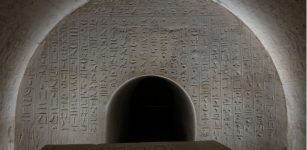 Magnificent Decorated Tomb Of Scribe Unearthed At Abusir Sheds New Light On Ancient Egyptian History
Archaeology | Nov 8, 2023
Magnificent Decorated Tomb Of Scribe Unearthed At Abusir Sheds New Light On Ancient Egyptian History
Archaeology | Nov 8, 2023 -
 2,000-Year-Old Stringed Instrument Found In Vietnam
Archaeology | Feb 22, 2023
2,000-Year-Old Stringed Instrument Found In Vietnam
Archaeology | Feb 22, 2023 -
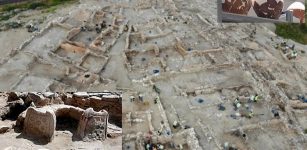 Anatolia’s Seyitömer Mound Was Inhabited In Bronze Age, Achaemenid, Hellenistic, And Roman Times
Archaeology | Aug 17, 2020
Anatolia’s Seyitömer Mound Was Inhabited In Bronze Age, Achaemenid, Hellenistic, And Roman Times
Archaeology | Aug 17, 2020 -
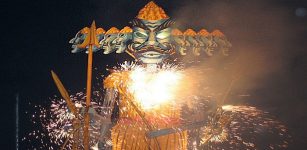 Ravana: Ten-Headed And Multi-Armed Demon King Of Lanka And Chief Antagonist In Epic Ramayana
Featured Stories | Oct 8, 2019
Ravana: Ten-Headed And Multi-Armed Demon King Of Lanka And Chief Antagonist In Epic Ramayana
Featured Stories | Oct 8, 2019 -
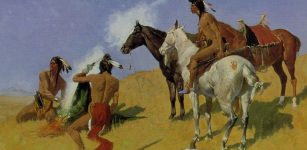 Ancient Ingenious Ideas Of Transmitting Messages Over Long Distances
Ancient Technology | Jan 30, 2019
Ancient Ingenious Ideas Of Transmitting Messages Over Long Distances
Ancient Technology | Jan 30, 2019 -
 Mystery Of The Ancient Unknown Mining Civilization In North America – Puzzling Archaeological Discoveries – Part 1
Ancient Mysteries | Apr 18, 2022
Mystery Of The Ancient Unknown Mining Civilization In North America – Puzzling Archaeological Discoveries – Part 1
Ancient Mysteries | Apr 18, 2022 -
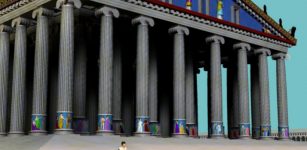 Herostratic Fame Relates To Herostratus Who Burned The Beautiful Temple Of Artemis To Become Famous
Ancient History Facts | Jan 6, 2017
Herostratic Fame Relates To Herostratus Who Burned The Beautiful Temple Of Artemis To Become Famous
Ancient History Facts | Jan 6, 2017 -
 3,400-Year-Old Cuneiform Tablet Excavated In Old City Of Alalah
Archaeology | Aug 23, 2020
3,400-Year-Old Cuneiform Tablet Excavated In Old City Of Alalah
Archaeology | Aug 23, 2020 -
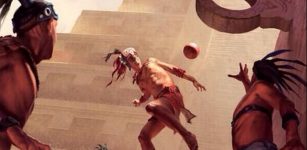 Mesoamerican Rubber Ball Game Tradition Existed Earlier Than Thought
Ancient Traditions And Customs | Mar 17, 2020
Mesoamerican Rubber Ball Game Tradition Existed Earlier Than Thought
Ancient Traditions And Customs | Mar 17, 2020 -
 Ankou: Breton Angel Of Death That Delivers Souls To The Underworld
Featured Stories | Mar 31, 2025
Ankou: Breton Angel Of Death That Delivers Souls To The Underworld
Featured Stories | Mar 31, 2025 -
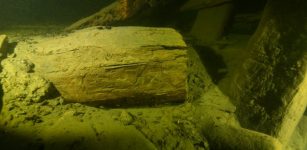 Barrels With Unique Intact Cargo Found On The Osmundvraket (Osmond Wreck)
Archaeology | Jun 7, 2024
Barrels With Unique Intact Cargo Found On The Osmundvraket (Osmond Wreck)
Archaeology | Jun 7, 2024 -
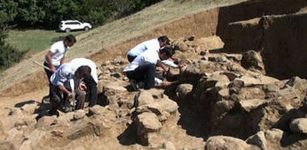 New Findings In Ancient Palidli Necropolis, Agdam Azerbaijan
Civilizations | Sep 24, 2015
New Findings In Ancient Palidli Necropolis, Agdam Azerbaijan
Civilizations | Sep 24, 2015 -
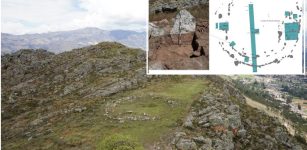 Callacpuma’s Megalithic Stone Circular Plaza Was Constructed Using A Technique Previously Unseen In The Andes
Archaeology | Feb 15, 2024
Callacpuma’s Megalithic Stone Circular Plaza Was Constructed Using A Technique Previously Unseen In The Andes
Archaeology | Feb 15, 2024 -
 Jörmungandr – Hideous Poison-Spewing Midgard Serpent Was One Of Loki’s Children
Featured Stories | Mar 31, 2018
Jörmungandr – Hideous Poison-Spewing Midgard Serpent Was One Of Loki’s Children
Featured Stories | Mar 31, 2018 -
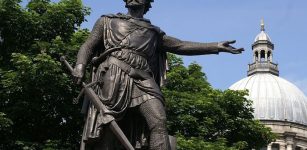 Sir William Wallace: Brave Scottish Knight And Legendary Hero
Featured Stories | Feb 27, 2016
Sir William Wallace: Brave Scottish Knight And Legendary Hero
Featured Stories | Feb 27, 2016 -
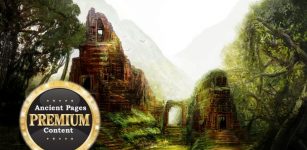 Ancient Monuments The World Is Not Allowed To See – Forbidden Zone – Part 2
Ancient Mysteries | Aug 27, 2020
Ancient Monuments The World Is Not Allowed To See – Forbidden Zone – Part 2
Ancient Mysteries | Aug 27, 2020


